Let’s dive into the captivating world of the Banded Fruit Dove. This unique bird, native to Southeast Asia and Oceania, is a sight. With its striking plumage and distinctive call, it’s easy to see why bird lovers are fascinated by this species.
The Banded Fruit Dove primarily inhabits subtropical or tropical moist lowland and mangrove forests. They’re known for their predominately frugivorous diet, meaning they feast almost exclusively on fruit.
These birds play an integral role in these ecosystems as seed dispersers, underscoring their significance in maintaining biodiversity.
You might be wondering about its name – well, it derives from the prominent bands you’ll find across its chest. Their vibrant colors vary between sexes, with males boasting more intense hues than their female counterparts.
So, next time you wander through an Asian or Oceanian forest, keep your eyes peeled for these remarkable creatures!
Physical Characteristics of the Banded Fruit Dove
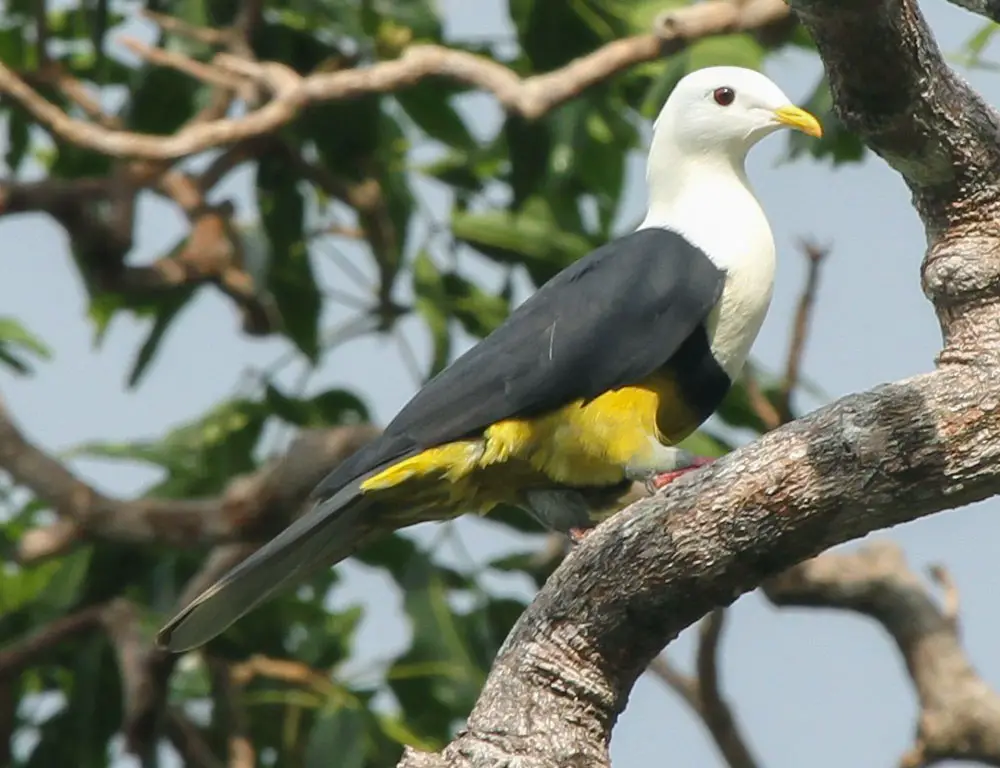
The Banded Fruit Dove (Ptilinopus cinctus) is a fascinating bird known for its striking physical characteristics. Here’s an overview of its notable traits:
Size
The Banded Fruit Dove typically measures between 23 to 27 centimeters (9 to 10.6 inches) in length, making it a moderately sized bird within the dove family.
Plumage
- Male: The male Banded Fruit Dove exhibits vibrant colors, with a predominantly green body adorned with white bands on the chest and wings. Its head is typically grey, adding to its overall striking appearance.
- Female: Female Banded Fruit Doves share a similar green body coloration with males but lack the distinct white bands. They may have a more subdued appearance compared to males.
Eye Color
One of the most distinctive features of the Banded Fruit Dove is its crimson-red eyes, which add an extra touch of exoticism to its appearance.
Wing Patterns
The wings of the Banded Fruit Dove are adorned with bands of green, yellow, and white, creating a visually appealing pattern that helps them blend into their forest habitat.
Compact Build
Despite its colorful plumage and striking appearance, the Banded Fruit Dove has a relatively compact build, contributing to its agility and maneuverability in its arboreal habitat.
Adaptations for Flight
Underneath its colorful exterior, the Banded Fruit Dove possesses strong wing muscles that enable it to fly long distances in search of fruiting trees, which form its primary diet source.
Habitat and Distribution of the Banded Fruit Dove
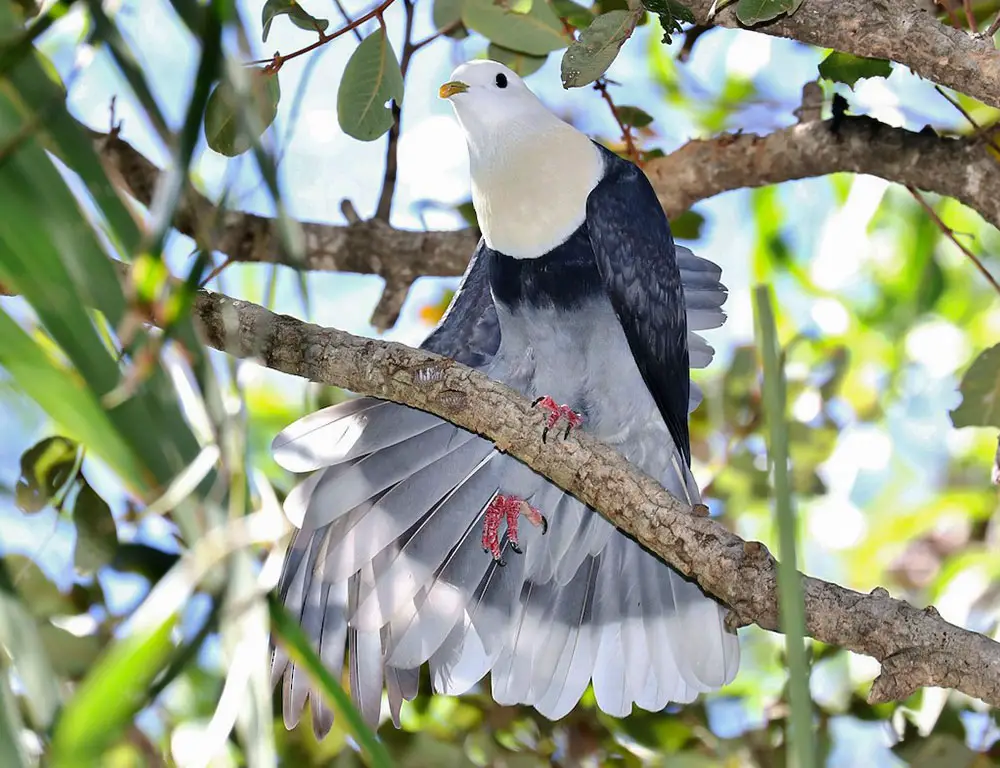
The habitat and distribution of the Banded Fruit Dove (Ptilinopus cinctus) reveal a species with a remarkable ability to adapt to diverse environments across Southeast Asia and Oceania.
Here’s an exploration of their habitat preferences and distribution patterns:
Habitat Preferences
- Southeast Asia: Banded Fruit Doves thrive in the lush forests of Southeast Asia, including Indonesia, Papua New Guinea, the Solomon Islands, and the northern regions of Australia. They prefer subtropical or tropical moist lowland forests and mangrove forests rich in fruit-bearing trees.
- Adaptability: These doves demonstrate remarkable adaptability, inhabiting environments ranging from dense rainforests to coastal areas and even human-altered landscapes like gardens. This adaptability is facilitated by their versatile diet, which includes fruits, seeds, and small insects.
Distribution Patterns
- Christmas Island: Christmas Island stands out as a significant habitat for the Banded Fruit Dove, being one of only two pigeon species native to this remote island. Its abundant figs, a favored food source, make it an ideal habitat for these birds.
- Widespread Distribution: Banded Fruit Doves have dispersed widely across their range in Southeast Asia and Oceania, reflecting their preference for regions with abundant fruit-bearing vegetation.
Conservation Implications
Understanding the habitat preferences and distribution of the Banded Fruit Dove is essential for its conservation. With ongoing deforestation threatening habitats within its range, protecting these ecosystems becomes crucial for ensuring the survival of this species.
Preserving the diverse habitats supporting Banded Fruit Doves populations is vital for maintaining our world’s beauty and ecological integrity.
Here are some key figures on their distribution:
| Region | Estimated Population |
|---|---|
| Indonesia | 20% |
| Papua New Guinea | 30% |
| Solomon Islands | 15% |
| Northern Australia | 10% |
| Other Areas | 25% |
Diet and Feeding Behavior of the Banded Fruit Dove
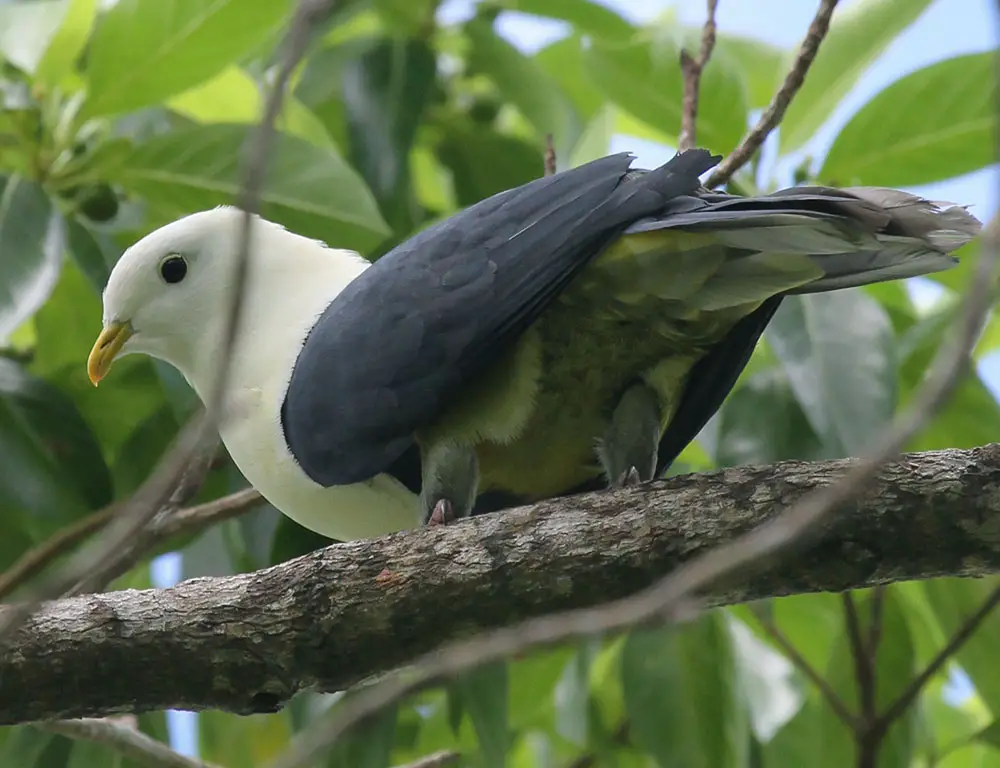
The diet and feeding behavior of the Banded Fruit Dove (Ptilinopus cinctus) are fascinating, reflecting their selective preferences, agile foraging techniques, and hearty appetites.
Here’s a closer look at their dietary habits:
Primary Diet
The Banded Fruit Dove is primarily frugivorous, meaning they predominantly consume fruits as their primary source of nutrition. Among fruits, they show a particular fondness for figs, a staple in their diet.
Their intense passion for fruits has earned them the nickname ‘fruit pigeons.’
Dietary Variety
In addition to figs, these doves also feed on a variety of other fruits, including berries and small fruits. Occasionally, they may consume seeds as well, showcasing some dietary versatility.
Feeding Behavior
Banded Fruit Doves exhibit an agile and adept feeding behavior, preferring to feed high up in the tree canopy where their favorite fruits are abundant. Unlike ground-feeding bird species, they delicately balance on thin branches while using their robust beaks to pluck ripe fruits.
This behavior allows them to access a diverse range of fruits and effectively exploit resources in their arboreal habitat.
Feeding Location
Their preference for dining high up in trees reflects their adaptation to the forest canopy environment, where most of their preferred food sources are found.
This arboreal lifestyle protects them from ground-based predators and competition from other bird species.
Daily Consumption
Banded Fruit Doves have hearty appetites and can consume a significant quantity of fruit daily. Their energetic foraging activities maintain their energy levels and meet their nutritional requirements.
Reproduction and Life Cycle of the Banded Fruit Dove
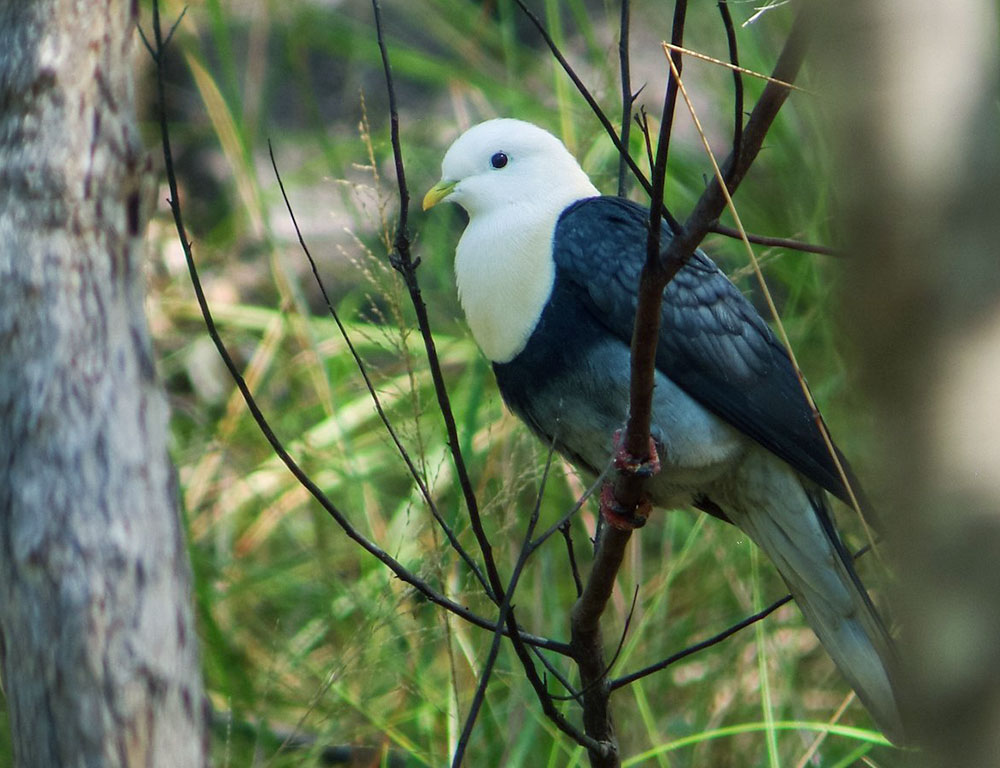
The reproduction and life cycle of the Banded Fruit Dove (Ptilinopus cinctus) unveil a fascinating journey marked by monogamous bonds, intricate courtship rituals, diligent parental care, and the challenges of survival in the wild.
Here’s a closer look at their remarkable life cycle:
Monogamous Bonds and Courtship
Banded Fruit Doves are monogamous birds, forming solid and enduring bonds with their mates for life. Their courtship rituals are elaborate and captivating, involving displays of preening, cooing, and the exchange of fruit gifts between partners.
These rituals strengthen the pair’s bond and reinforce their commitment.
Nesting and Egg-laying
Once a pair has formed, the female dove lays one or two cream-colored eggs in nests constructed from sticks and leaves. The male actively participates in nest-building and gathering materials while the female focuses on construction.
This collaborative effort ensures the nest is secure and well-prepared for the arrival of their offspring.
Incubation and Parental Care
Both parents equally share the responsibility of incubating the eggs, which typically lasts about two weeks. During this period, the parents diligently tend to the nest, keeping the eggs warm and protected.
After hatching, the fragile chicks receive attentive care from both parents, who feed them “crop milk,” a nutritious substance adult doves produce.
Development and Fledging
As the chicks grow, they quickly become sturdier under the care of their parents. By around four weeks of age, the young doves are ready to take flight and begin exploring their surroundings independently.
However, they continue to receive guidance and support from their parents for several more weeks until they are fully prepared to fend for themselves.
Lifespan and Survival Challenges
Banded Fruit Doves can live up to 20 years in captivity, showcasing impressive longevity among bird species. However, life in the wild presents various challenges, including predation and habitat loss, which can significantly impact their lifespan.
Despite these challenges, the Banded Fruit Dove’s resilience and adaptability enable it to persist in its natural habitat.
Conservation Status of the Banded Fruit Dove
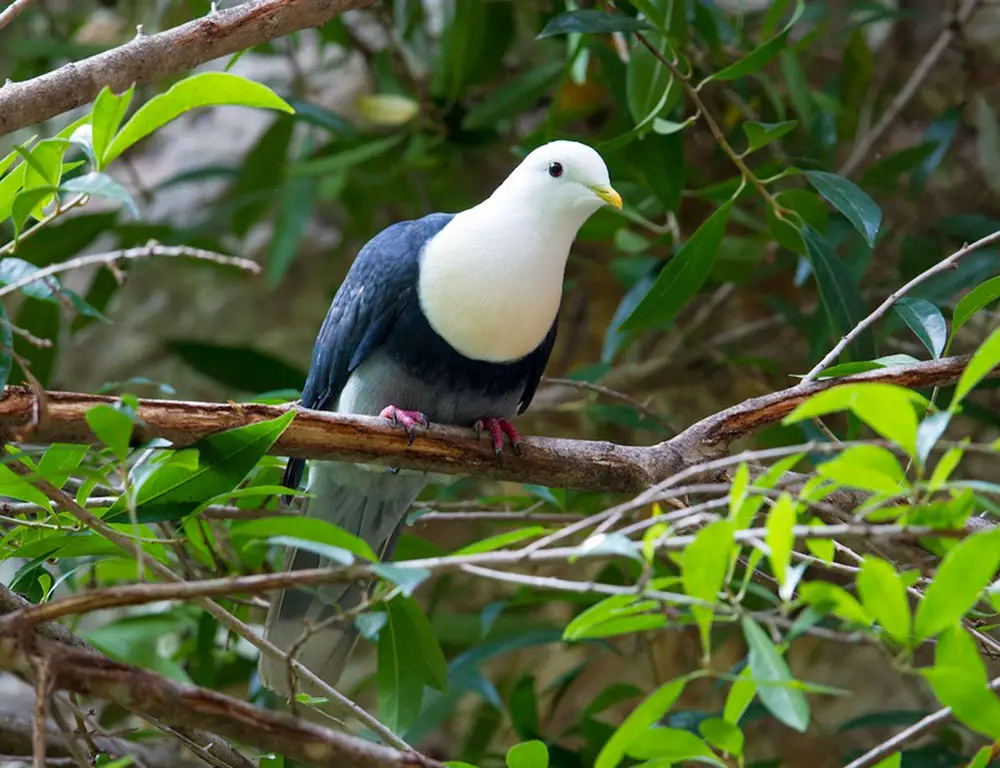
The conservation status of the Banded Fruit Dove (Ptilinopus cinctus) is a matter of concern despite its current classification as “Least Concern” by the International Union for Conservation of Nature (IUCN).
While this designation suggests that the species is not immediately threatened with extinction, it does not signify long-term security for its survival.
Let’s delve into the complexities of its conservation status:
Population Trend
The population trend of the Banded Fruit Dove is decreasing, indicating a decline in numbers over time. This decline can be attributed to various human activities, including deforestation, hunting, and habitat fragmentation.
Pressing Conservation Issues
- Deforestation: The Banded Fruit Dove relies heavily on primary forests for its habitat and food sources. However, these forests are rapidly disappearing due to logging and land conversion for agricultural purposes, threatening the species’ survival.
- Hunting: Hunting Banded Fruit Doves for food or trade further exacerbates their population decline, particularly in areas where they are heavily exploited.
- Habitat Fragmentation: Fragmentation of forest landscapes isolates populations of Banded Fruit Doves, leading to reduced gene flow and genetic diversity. This isolation increases their vulnerability to environmental changes and disease outbreaks.
- Loss of Genetic Diversity: Decreased genetic diversity resulting from habitat fragmentation and isolation heightens the species’ susceptibility to genetic disorders and reduces its ability to adapt to changing environmental conditions.
Ecological Importance
The conservation of the Banded Fruit Dove is crucial for safeguarding the species and preserving the integrity of forest ecosystems.
These doves play a vital role in seed dispersal, facilitating the regeneration and maintenance of plant diversity within their habitats.
Conclusion
Exploring the Banded Fruit Dove reveals a captivating bird with a vital role in ecosystem health. Their vibrant colors and unique band patterns enchant enthusiasts and conservationists alike.
Predominantly fruit-eating, they contribute significantly to forest regeneration through seed dispersal. Tropical rainforests, their preferred habitat, offer abundant food and nesting sites yet face deforestation and climate change threats.
Deforestation rates show a concerning upward trend over the years, directly impacting their habitat. Conservation efforts, including protected areas, sustainable farming, and awareness campaigns, aim to safeguard their future.
Preserving these remarkable creatures ensures future generations can marvel at their beauty and underscores our responsibility as stewards of nature to protect them from environmental threats.